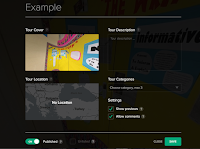Last Friday the Literacy Coach meeting was expanded to include teachers from grades 2-12 to engage in a protocol around identifying ELA Power Standards in each of these grades. To Ainsworth's point, since our adoption of the Common Core State Standards, we have never had the opportunity to work in vertical teams like this, discussing and selecting priority standards based on a shared set of criteria. At the middle school level, I believe our extensive work in content PLGs and the collaboration among the coaches both here and in the 5DP have helped us think about the standards we prioritize, but that criteria on which to prioritize standards had been more implicit. Before jumping into the standards themselves, the protocol in which we engaged began with an explicit explanation of the criteria all grade-level teams would use to select power standards.
We discussed the standards using these four criteria:
- Endurance: extends beyond one year of learning. Applies to real-life concepts & skills students will need beyond your class/school
- Leverage: Has application in contents disciplines other than yours Readiness for the next level of learning: contains the knowledge and skills students need in order to move onto the next level
- External Exams: will be assessed on standardized exams, i.e. Common Assessments, MCAS 2.0 (Criteria descriptions "Priority Standards: The Power of Focus" Ainsworth)
The Protocol
With our shared understanding of the criteria by which we should be evaluating the standards, our director, Dr. Porter, charged us with the task of identifying just 10 priority standards for our grade level. To organize this, she had placed chart paper around the room labeled with each of the 5 strands and how many standards we should prioritize per strand: Reading Literature(3-4), Reading Informational Text(3-4), Writing(3), Speaking & Listening(2), and Language (2).
My grade-level team consisted of myself and Briana, a 6th grade ELA teacher at SBA. Each grade level team began by independently reading through all standards in the Reading Literature Strand and independently selecting 3-4 RL standards using the four criteria. Once we had our agreed-upon standards we posted them on our grade level chart paper. We then discussed our standards with the grade level team above and below us to see the connection or lack thereof in our standards selection. There were certainly some differences, but often times when we looked at each particular grade's version of a standard, it helped us make sense of why they had been selected. In a few cases, teams elected to remove or swap out a standard they had initially selected.
When Briana and I came together to discuss our selected standards we noticed a couple things. First, that we had each focused on many of the same standards and we only had to work to come to an agreement on the 4th of our 4 selected standards. Secondly, we had both used Endurance as our main lens for thinking about which standards to prioritize. This big-picture thinking is essential, I think, but I also noticed as we moved through the strands and consulted with other grades that we had to adjust our standards at times when we incorporated more of the other criteria. Readiness, for example, was a criterion that we used more in our discussions with vertical teams about how the standards should build on each other.
We repeated this same process of independent selection, grade-level team agreement, vertical team discussions for each of the remaining four strands. The original parameters from Dr. Porter had given us the freedom to select up to 15 power standards over the strands, with the understanding that eventually we want to evaluate further to get our number as close to 10 as possible. In our remaining time, we worked to see where we could make eliminations or consolidations in some cases. Many grade level teams chose to view RL/RI standards 1 and/or 2 as the same general standard with different text-types.
Points to Consider
- These charts of selected standards are DRAFTS and remain open for revision and suggestions for other grade-level teachers who were not present during the protocol. So please consider your grade level's draft and please feel free to send along feedback about the standards.
- This does not change anything for the current school year. Once the Drafts are revised and finalized during Spring 2018. we will adopt the Power Standards beginning in the 2018-2019 school year.
- Selecting Power Standards does not mean all other standards are obsolete and can be ignored. The 10-ish standards that make it to the finalized Power Standards documents are the ones you will continue to teach and weave into your instruction on a year-long basis. The remaining standards will be divided up into the Quarter Anchor Units based on where it makes sense to emphasize those particular standards. This work begins October 27th.
- You'll notice Writing standards 1, 2, & 3 are absent from the posters. These writing standards are already emphasized in certain quarters of the year based on your anchor unit and the benchmark assessment. Those writing standards remain where they are, emphasized in each particular quarter, but the Power Standards in the drafts reflect additional writing standards that meet the criteria for year-long priorities.
Click Here to see a document I created to see the full chart pictured above. I made a chart for grades 5-9 to give us a complete picture of where our students are coming from and where they are going. I look forward to hearing your thoughts about this and to continue this work with anchor units.

























